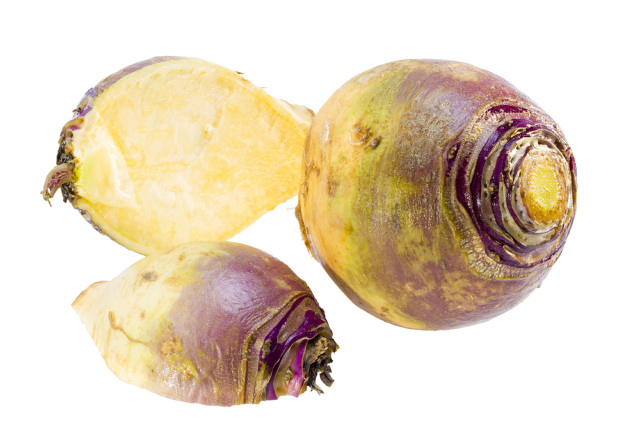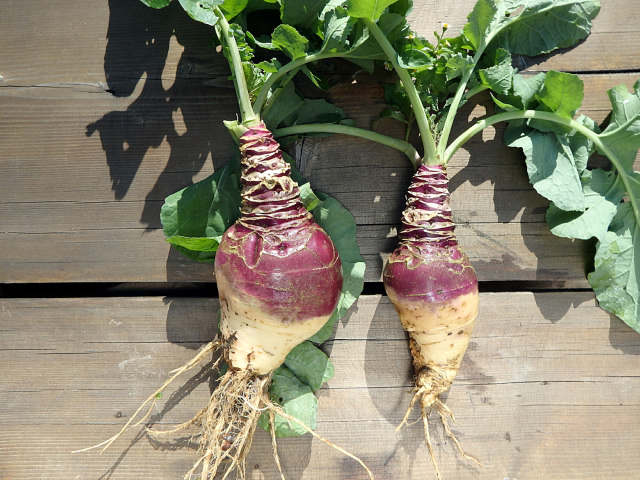Whether you’re growing rutabaga from seed or picking it up at your local market, you know that not all rutabagas are created equal. You may learn this the hard way when incorporating rutabaga into a recipe only to find it’s too bitter to even attempt to eat. The risk of accidentally biting into a bitter rutabaga isn’t worth giving up on this nutritious vegetable altogether, though. Instead, keep reading to learn about the different factors that could contribute to bitter rutabaga.
Table of Contents
What is Rutabaga?

The rutabaga is a root vegetable and member of the family brassicaceae. They’re often confused with turnips or radishes because of their extremely similar appearance thanks to being closely related.
They range in color from white to purple and have yellow-tinted flesh under the peel. Rutabaga is made up of a large round fleshy root (about the size of a softball) and long stalks of green leaves that resemble mustard leaves.
Both the flesh and the leaves of the rutabaga are edible, making it a highly versatile vegetable for cooking! They’re popularly roasted, mashed like potatoes, grilled, or eaten raw (though most people prefer them cooked). The greens are tender when sauteed but can also be added fresh to salads after a good rinse.
What Does Rutabaga Taste Like?
Ripe, raw rutabaga will taste a bit like a turnip: earthy and slightly sweet, with a very mildly bitter finish. It will also have a hint of the peppery punch that you often taste in radishes.
The texture of rutabaga is almost identical to a turnip: uniformly crisp. Which isn’t a surprise as the two root vegetables are closely related.
The exterior of rutabagas is waxed before selling. So if you purchased yours from a grocery store, you should remove the wax and peel it before eating.
Roasting, boiling, steaming, and sautéing are all popular methods of cooking rutabaga. When cooked, the root will soften and the flavor will mellow, enhancing the more sweet notes as the sugars that are naturally present in the flesh caramelize.
Some rutabagas are far more bitter than others, however, and you could find them unpleasant if you get one with a very sharp taste.
Why Your Rutabaga Is Bitter (and Potential Fixes!)
Your rutabaga is likely bitter because of one of the following reasons: you selected poor quality rutabaga, something went wrong in the growing process, incorrect storage, or old age.
Poor Selection
You may have accidentally purchased bitter rutabaga because you’re not sure what qualities to look for when selecting rutabaga in the produce aisle!
Select purple-tinted rutabaga with minimal bruising or damage as you would with any other fruit or vegetable. The bruising can cause a breakdown in the cell wall of the veggie that can cause a displeasing taste and mushy texture.
Rutabagas should also be firm with little give when squeezed. Soft rutabagas will be hard to cook with and won’t taste right.
Also make sure the rutabaga isn’t growing a new start, as this is a good indicator that it’s overripe. If you spot green sprouts near the stem, avoid it and select another.

Rutabaga Growing Problems Cause Bitterness
There are several factors that could contribute to your rutabaga becoming too bitter during the growing process.
It’s Too Hot to Grow Rutabaga
Rutabaga is a colder-weather vegetable. When grown in a cooler season, rutabagas are mildly sweet and tender. If temperatures in your area are reaching over 70°F (21°C) on a regular basis, you likely planted too late (or too early in the case of fall crops) and you’ll wind up with sharper-tasting rutabaga.
It’s Too Dry to Grow Rutabaga
Drought or underwatering are also common causes of bitterness in rutabagas. Make sure your rutabagas receive an average of 1 inch of water per week to ensure they’re adequately hydrated.
Incorrect Storage of Rutabagas
Different types of vegetables have different rules for storage and it can be hard to keep track of them all. Especially for vegetables you might not be familiar with or use all the time. Your rutabaga may have gotten bitter because you stored it in a warm place like on a counter in direct sunlight or on top of a cabinet or refrigerator.
So, where should you store your rutabaga? The best place for it (raw or cooked, cut or whole) is in the refrigerator or freezer! To prep rutabaga for refrigerator storage, all you need to do is put it in a sealed container or plastic bag. These Stasher bags work well for those who try to go as plastic-free as possible! Or wrap it up.
Raw rutabaga can be kept in the fridge for up to five weeks. And cooked rutabaga is best consumed within a few days. In the freezer, properly prepared rutabaga can last up to 18 months! Though canning is an option for rutabagas, it’s not recommended because of flavor and color inconsistencies.
The Rutabaga Has Gotten Old
It’s also possible that your rutabaga is bitter because it may have aged past its prime. (It’s okay–we’re all guilty of neglecting our well-intentioned produce from time to time).
At room temperature, rutabaga can deteriorate within a few days or even hours depending on the humidity of your climate.
How to Tell if a Rutabaga is Still Good
You can check to see if your rutabaga is still fresh enough to eat by inspecting it as you would any other vegetable.
If you see mold or discoloration, if it’s gone soft, or if it smells offensive (though rutabagas don’t exactly smell like flowers in the first place), toss it out and try again with a fresh one.
What to Do with a Bitter Rutabaga
If you find you accidentally grew or purchased bitter rutabaga, worry not! All is not lost (yet). You can still eat bitter rutabaga in most cases. If you notice your rutabaga is tough or woody instead of crunchy and firm, it’s likely too bitter to save.
If your rutabaga isn’t on the totally inedible spectrum of bitterness and is only mildly sharp, you can still use it! It’s difficult to mask the bitterness when raw, so to potentially salvage your harvest, you’ll have to cook it.
Adding some kind of sweetness, fat, or acid (usually a combination of all three) to roasted or mashed rutabaga is the easiest way to counteract the bitterness. Incorporating honey, maple syrup, cane sugar, butter, lemon juice, or vinegar can help bring a little more balance to overripe rutabaga.
Alternatively, you can add more savory spices to help mask the bitter flavor. The stronger the spice, the better the camouflage. Try heating things up with cayenne or chili flakes to distract your palate!
Related Reading:
